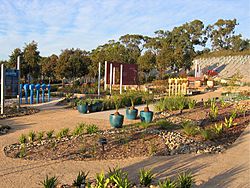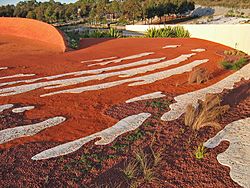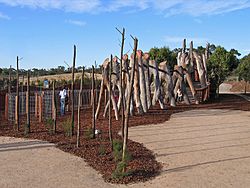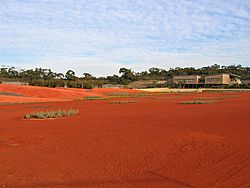Royal Botanic Gardens, Cranbourne facts for kids
The Royal Botanic Gardens Victoria at Cranbourne Gardens is a special place near Melbourne, Australia. It's like a huge park that focuses on Australian native plants. This garden is part of the Royal Botanic Gardens Victoria, with the other part being in the center of Melbourne. Cranbourne Gardens is about 45 kilometers (28 miles) south-east of Melbourne city.
This amazing garden covers 363 hectares (about 900 acres). It has different natural areas like heathlands, wetlands, and woodlands. It's also a home for many native animals, including birds, mammals, and reptiles. Some of these animals are rare or endangered, meaning they are at risk of disappearing forever.
A very popular part of Cranbourne Gardens is the Australian Garden. It opened on May 28, 2006. This area has many special gardens, cool sculptures, and displays. They are all designed to show how beautiful and diverse Australian landscapes and plants are.
Beyond the Australian Garden, there's a large bushland area. It has 10 kilometers (6.2 miles) of walking paths. You can also find the Trig Point Lookout tower, quiet picnic spots, and free barbecue areas there.
Contents
A Look Back: History of the Gardens
The land where Cranbourne Gardens is today was once home to the Boon Wurrung people, who are Indigenous Australians. For a long time, starting in the 1820s, the site was used for digging up sand. This sand helped build Melbourne and its nearby towns. The military also used the area from 1889 until 1953. People also had permission to use the land for things like grazing animals and collecting timber.
In 1970, this site officially became part of the Royal Botanic Gardens Victoria. Its main goal was to study and protect Australian plants. The gardens didn't open to the public until 1989. The Australian Garden was planned for many years. When it finally opened on May 30, 2006, about 15,000 people visited on the very first day!
Exploring the Australian Garden
The Australian Garden helps visitors understand their place in the Australian environment. It also teaches them more about Australian plants. This garden features about 100,000 plants! They are spread across fifteen different landscape displays and special exhibition gardens.
The Australian Garden was designed by Taylor Cullity Lethlean Landscape Architects with Paul Thompson. It has won many design awards. The garden is still growing, with new parts planned to be built in the future.
The Red Sand Garden
The Red Sand Garden is the main attraction in the Australian Garden. It has bright red sand with circles of saltbush plants. There are also crescent-shaped mounds. These designs copy the shapes and colors you might see in Central Australia's deserts. This garden is made to show off the beautiful wildflowers that bloom in the deserts during different seasons.
Special Exhibition Gardens
There are five special exhibition gardens. They show how you can use Australian native plants in your own home garden.
- The Diversity Garden displays many different native plants from various climate zones in Australia.
- The Water Saving Garden teaches you how to group plants that need similar amounts of water. It also shows plants that don't need much watering.
- The Future Garden explores new ways of gardening, like special plant choices and different types of mulches.
- The Home Garden features native plants for common types of Australian homes.
- The Kid's Backyard uses natural plant materials to create a fun play area for children. This is different from the usual plastic and metal play structures.
Arid Garden and Dry River Bed
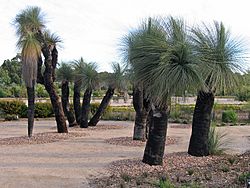
These gardens show how important water is in the Australian landscape. Many parts of Australia often switch between very dry periods (droughts) and heavy floods. Because of this, plants have had to evolve to handle long times of intense heat and dryness, as well as sudden, large amounts of water.
Eucalypt Walk
Eucalypt trees are a common sight in Australia. There are about 700 different types found almost everywhere. The Eucalypt Walk has five gardens that show some well-known eucalypt species. These include the Ironbark Garden, the Box Garden, the Peppermint Garden, the Bloodwood Garden, and the Stringybark Garden. These trees are still young, but they will grow into large, mature trees over the next century.
Other Cool Features
The Rockpool Waterway and Escarpment Wall are inspired by the waterways and steep cliffs you might find in central Australia. Places like Uluru and Kings Canyon have similar features. There's also a display of Australian orchids under the Visitor's Centre. You can walk along the Serpentine Path, and kids can play and learn at the Desert Discovery Camp in the Arid Garden.
The Australian Garden also has a visitor information desk, guided walks, and educational programs. Volunteer gardeners are there to help with advice on using Australian plants. There's also a gift shop and a cafe.
Planning Your Visit
Opening Hours Cranbourne Gardens is open every day from 9:00 AM to 5:00 PM. The only day it's closed is Christmas Day. It's free to enter the gardens! However, the bushland areas are closed on days when there is a Total Fire Ban to keep everyone safe.
How to Get There Cranbourne Gardens is located at 1000 Ballarto Road, Cranbourne. If you're driving, you can get there via the South Gippsland Highway. You can also use public transport like trains and buses from Melbourne. If you take public transport, it's a good idea to get a taxi from Cranbourne Station, as the walk to the gardens can be quite long.
See also
 In Spanish: Real jardín botánico de Cranbourne para niños
In Spanish: Real jardín botánico de Cranbourne para niños


